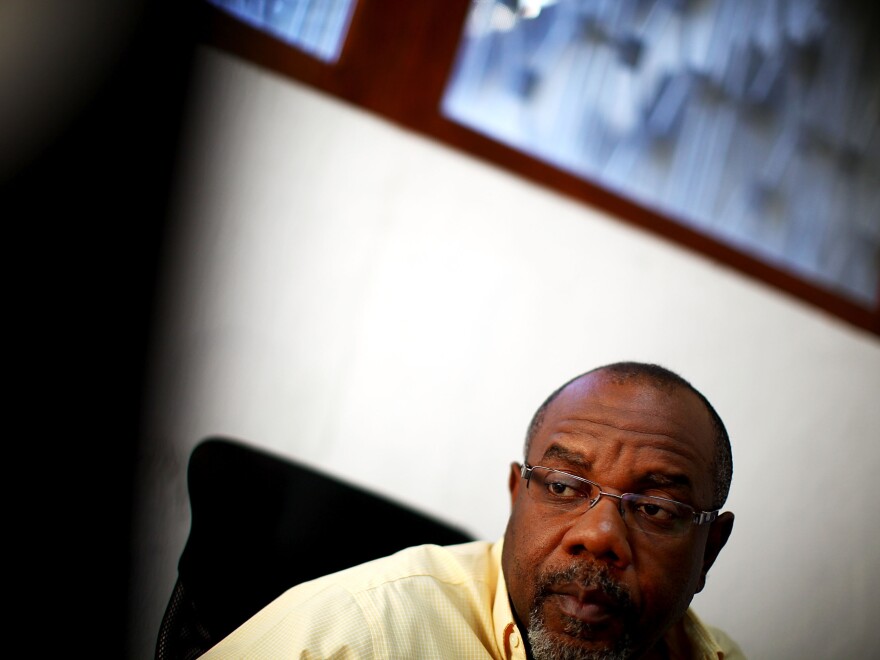Saturday marks the third anniversary of the powerful earthquake that destroyed much of the Haitian capital, Port-au-Prince. The quake killed roughly 200,000 people and left 1.5 million Haitians homeless.
Despite billions of dollars in international aid and pledges to help Haiti rebuild from the disaster, very little new, permanent housing has been built. And about 350,000 Haitians are still living in squalid, makeshift camps — where they face an array of health challenges.
There's been an epidemic of sexual assaults on women living in the camps. And residents complain that unsanitary conditions and numerous cooking fires in the cramped quarters have caused respiratory problems among the children.
Fears, however, that cholera would spread rapidly through the overcrowded settlements never materialized. Aid workers say this was probably because of the treated water distributed in the camps.
When the earthquake struck in January 2010, Jacqueline Syra was nine months pregnant with her third child. Her house near the sprawling slum of Cite Soleil collapsed, she says, killing her husband.
Syra, along with tens of thousands of other people, moved on to an abandoned military airport known as La Piste.
Syra never expected that three years later, she'd still be living on the runway.
"We are not living well in the tents," she says. "Sometimes men get in here and attack me or rob my things."
Her shack is a patchwork of fraying tarps that are tied together with blankets and strung over a skeleton of mismatched sticks. Two motorcycle tires on the roof keep the cloth from flapping in the wind. She uses the front of an old portable toilet as the door to her shelter. There's no electricity, and she cooks on the dirt floor.
Syra shares this shelter with her three children.
"I don't sleep well, I don't eat well," says the rail-thin, 49-year-old mother. "I was a fat woman, and look at me now. I lost a lot of weight because I cannot sleep or eat well here."

At its peak in 2010, this camp held roughly 50,000 residents, according to humanitarian officials. La Piste is less crowded now, but there are still tens of thousands of people here. Women bathe naked with buckets at the public water taps. Kids scurry along trash-filled ditches.
"I don't know when I'll leave," Syra says. "I don't know how long I'm going to be here."
After the quake, international aid agencies were busy keeping people alive, says United Nations spokesman George Ngwa. They provided Haitians with basic tarps for shelter, removed most of the rubble, paved roads and, yes, even built some housing.
"I do understand those who think that there isn't much to show for all that has happened since 2010, but there is a lot that has happened," he says.

But Ngwa, who works at the UN's Office for the Coordination of Humanitarian Affairs in Haiti, does admit that some mistakes were made in the rush.
For example, "new houses were built in areas that had no sustainability in terms of jobs for the people who were supposed to move there," he explains. "So some of them abandoned the new houses, and they're back in the camps."
Immediately after the quake, billions of dollars were pledged by international donors to help Haitians recover. Despite this, only about 5,000 units of permanent housing have been built.
The grand plans to "build back better" have evaporated.
Instead, President Michel Martelly launched a program aimed at getting people to leave the camps. The government offered them a rental subsidy of $500 and $150 in cash to anyone willing to vacate several public parks; 100 percent of the residents in all of the targeted camps agreed to the deal and moved out.
"The overall budget for this program was $78 million," Clement Belizaire, who directs the relocation and rehabilitation in the government's reconstruction program, tells Shots.
He says his office initially focused on trying to repair the damaged houses of camp residents. But this only affected about 10 percent of the camp population, he says, and only temporarily.
"So after a while, that 10 percent is replaced, the camp fills back up. So we came [up] with a rental subsidy," he explains. "That's only when we started to see camps that were cleared completely."

His program is also involved in building several dozen new houses and rehabilitating destroyed public infrastructure — roads, electricity lines and sewers — in neighborhoods that are receiving thousands of the former camp residents.
Rose Lermonis, who moved with her family into a tarp-covered shack in a public park after the earthquake, should be one of the success stories of Belizaire's resettlement program.
The 52-year-old mother spent more than a year in what she says were terrible and terrifying conditions in the camp. Then in November 2011, she got a subsidy to rent a small cinder block hut. But once that money was gone, she could no longer pay the rent and had to move with her children to a room owned by her sister.
"You see, all the people who used to be in the tents are still living in misery, because they don't have jobs," she says. "If they don't have a child or someone to support them, they have nothing."
Before the earthquake, Haiti was the poorest country in the Western Hemisphere. As it moves on from the disaster, the nation is still burdened with all the problems it had before its capital was destroyed.
Copyright 2020 NPR. To see more, visit https://www.npr.org. 9(MDAwMzY5MzE4MDEzMTE3ODg5NDA4ZjRiNg004))












